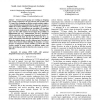50 search results - page 10 / 10 » A New Two-Party Identity-Based Authenticated Key Agreement |
TCC
2007
Springer
13 years 11 months ago
2007
Springer
Assume that two distant parties, Alice and Bob, as well as an adversary, Eve, have access to (quantum) systems prepared jointly according to a tripartite state ρABE. In addition, ...
ASIACRYPT
2004
Springer
13 years 11 months ago
2004
Springer
Secret handshakes were recently introduced [BDS+ 03] to allow members of the same group to authenticate each other secretly, in the sense that someone who is not a group member ca...
CORR
2011
Springer
12 years 9 months ago
2011
Springer
In studying how to communicate over a public channel with an active adversary, Dodis and Wichs introduced the notion of a non-malleable extractor. A non-malleable extractor dramat...
WCC
2005
Springer
13 years 11 months ago
2005
Springer
A secret handshake mechanism allows two entities, members of a same group, to authenticate each other secretly. This primitive was introduced recently by Balfanz, Durfee, Shankar, ...
AICT
2010
IEEE
12 years 9 months ago
2010
IEEE
— Several research groups are working on designing new security architectures for 4G networks such as Hokey and Y-Comm. Since designing an efficient security module requires a cl...

